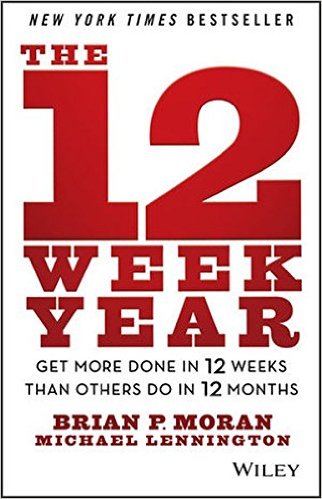
Book Summary – The 12 Week Year

The 12 Week Year
By Brian Moran and Michael Lennington
Too often we overcomplicate things in life. Moran and Lennington have taken all of the guidance on productivity / getting things done and distilled it down to a simple, easy to follow, intuitive execution framework that helps you to get things done. The basic principles are very straightforward:
- Quit building yearly plans. Break the year into 12 week periods
- Make sure you have a clear vision that drives what you are doing
- Understand that you have make your plan, score your plan, and adjust as things change
- Realize that the only thing stopping you from implementing this system is your willingness to embrace personal accountability
I’ve read a ton of books and been to numerous trainings on getting things done. I can’t say that I learned a lot of new concepts from this book. HOWEVER, it is probably the clearest, most concise, easiest to understand framework that I have seen.
If you are interested in getting more accomplished, embracing their framework / stepping up to the challenge they have put forward to break the year into 4 x 12 week blocks is going to bring you a step change in productivity and results. If you are not, you can continue on with the approach you have used in the past. But fair warning, using the same approach is in all likelihood going to deliver the same results.
Personally I’ve started to put SOME of the principles of the book into place and plan to put more into place over this next 12 weeks. I can honestly say that this book has already had an impact on the way I do things.
Below I have elaborated on the principles in the text in more detail. I’d encourage you to review these principles; and, if they resonate with you, pick up the book. Also, my friend Jaime Jay was nice enough to put together an Excel spreadsheet that you can use to build your personal 12 week plan. You can get a link to this tool here.
Key Ideas From “The 12 Week Year”
- Often the things we think we know are wrong! Only through challenging our thought patterns can we make major changes
- Redefining the year as 12 weeks versus 12 months has the opportunity to massively increase what we get done
- We see this same concept via periodization that is used by athletes
- We are wired to procrastinate/get things done at the last minute. 4 x 12 week “years” gives us 4 times a year to get the year end push!
- It’s all about what you believe / everything starts in your mind. While they did not include Stephen Covey’s quote of “All things are created twice. First mentally and second physically”, this is exactly the point they are making
- CORNERSTONE IDEA – Break your planning cycle into a 12 week period
- CORNERSTONE IDEA – Plan every week
- CORNERSTONE IDEA – Measure your performance EVERY week. Those readers familiar with annual reviews will quickly recognize what happens when you have to report out on your results
- CORNERSTONE IDEA – You need to be ruthless in blocking your time. Intentionality of time management is critical
- BIGGEST REALIZATION IN THE ENTIRE BOOK – Accountability is NOT about having someone else “hold us accountable”. It’s about recognizing that accountability speaks to your character and that you need to be accountable to yourself to get things done!
- There is a big difference between “interest” and commitment. Commitment involves
- A Strong desire
- Keystone actions
- Counting the costs associated with these actions
- Act on your commitments versus how you feel (i.e. often times we don’t feel like doing what we know we should!)
- CORNERSTONE IDEA – You cannot control the past. You cannot control the future. You can only control what you do at this moment. Live in the moment
- CORNERSTONE IDEA – To be successful you have to embrace NOT getting certain things done. Choose where you focus for the next 12 weeks and accept somethings will not get done. They describe this as intentional imbalance
- Execution of their system is based on 3 principles and 5 disciplines
- Principles
- Accountability
- Commitment
- Greatness in the Moment
- Disciplines
- Vision
- Planning
- Process Control
- Measurement
- Time Use
- As you make this transition. It will be uncomfortable as it involves change. The change cycle / progression through the cycle is:
- Uninformed Optimism – This is where you believe it will be easy
- Informed Pessimism – This is where you recognize it is NOT easy
- Valley of Despair – This is where you become convinced you CANNOT do it
- Informed Optimism – This is where you start to see the benefits of change
- Success and Fulfillment – This is where you have changed and see the results
- CORNERTSTONE IDEA – You MUST have a vision to make this system work. Without a vision, you will have no emotional connection to your tasks and you will in all likelihood fail. In creating a vision you need to think of:
- Impossible – Ideas that are so grand they seem unachievable
- Possible – A half step back from the impossible / breaking it down into things that seem doable.
- Probable – Taking it the next step to where it seems likely
- Given – Taking it the next step to where it is a given
- This cycle is ongoing and must be repeated.
- Your vision needs to be aspirational
- Pitfalls associated with visions:
- You don’t take the power of the vision seriously
- The vision isn’t meaningful to you
- Your vision is too small
- You don’t connect your vision to your daily actions
- Success tips on creating a vision:
- Share it with others
- Stay in touch with your vision
- Live with intention
- Framework for building a 12 week plan (very simple BUT very powerful!):
- Establish your goals
- Break your goals into tactics to be applied weekly
- FOCUS ON THE TACTICS
- Having a solid plan fosters execution
- Success criteria for goals / this is a variant of the traditional SMART goal concepts
- Goals must be specific and measurable
- You must state them positively
- You must ensure they are a realistic stretch
- You must assign accountability
- They must be time-bound
- Pitfalls associated with executing your 12 week plan:
- Your 12 week plan does not align with your long-term vision
- You aren’t staying focused
- You don’t make the tough choices
- You don’t keep it simple
- You don’t make it meaningful
- CORNERSTONE PRINCIPLE – What gets measured gets done. Therefore you must put a control process in place to succeed
- Process needs to make sure things get done each week
- The suggested weekly routine is simple:
- Score your week
- Plan your week
- Participate in a Weekly Accountability Meeting (WAM)
- Scoring does not need to be complicated. Keep it simple. Count the number of tasks you complete and shoot for 85%. Authors suggest that if you hit 85% of your tasks you will have a high probability of success
- Pitfalls associate with scoring:
- You think that measurement is complicated and unimportant
- You don’t schedule a block of time each week to assess your progress
- You abandon the system when you don’t score well
- Success tips associated with scoring:
- Review your weekly score with a buddy or a small group of peers each week
- Commit to make progress each week
- Remember that a weekly score of less than 85 isn’t necessarily bad
- Don’t be afraid to confront what the numbers are telling you
- CORNERSTONE PRINCIPLE – You need to take back control of your day. A large part of the challenge individuals face is that they do not manage their time:
- You need to block the day out into:
- Strategic blocks – These are three hour blocks where you work ON your business versus IN your business. Normally a single three hour block will be adequate each week
- Buffer blocks – These are 30 to 60 minute blocks of time where you deal with the various administrative tasks that you need to do on a daily basis. Normally you need one or two of these each day
- Breakout blocks – These are three hour blocks where you are free to enjoy yourself and embrace your creativity. You MUST have at least one of these every week to avoid burnout
- Other blocks – Time slots where you include the other things that “must be done”. These often center around the “traditional” view of work
- It is the concept of strategic, buffer, and breakout blocks that are critical / that you must embrace / that involve a new way of thinking
- Common pitfalls associated with time management:
- You conduct business as usual
- You don’t focus on one thing at a time in your strategic block
- You allow distractions to steal your attention
- You think being busy is the same as being productive
- Success tips associated with time management:
- Work from a written weekly plan
- Input your model week into your calendar
- CORNERSTONE CONCEPT – Ultimately it is all about accountability. You alone are responsible for doing the right things every day. You need to take ownership:
- Resolve never to be the victim again
- Stop feeling sorry for yourself
- Be willing to take different actions
- Common pitfalls associated with accountability:
- You continue to view accountability as consequences
- You look outside yourself
- Success tips associated with accountability:
- Acknowledge reality
- Focus on what you can control
- CORNERSTONE CONCEPT – Ultimately it comes down to commitment. Commitment can be defined as “The state of being bound emotionally or intellectually to some course of action”:
- There are two key categories of commitments: personal commitments and commitments to others
- You need to recognize that with commitments there is often a conscious stated intention versus an unconscious hidden intention. BE REAL WITH YOURSELF AND THINK ABOUT THIS!
- Process to determine what you LIKELY will be able to commit to:
- Determine a goal that would represent a real breakthrough
- Identify the keystone action required to reach this goal
- Determine the cost you will have to pay
- Determine which keystone actions you are willing to pay the price for
- Common pitfalls associated with commitment:
- You miss a commitment once and give up
- You fail to confront missed commitments
- You don’t value your word
- Success tips associated with commitment:
- Don’t overcommit
- Go public with your commitments
- Buddy up
- The first 12 weeds / getting started is often the hardest thing to do. This is because:
- We want immediate gratification
- We try and do too much
- We fall back into old habits
- We get into “victim thinking”
- You need to block the day out into:
- Principles
Hopefully you will be able to put several of these ideas into practice. Also, a reminder, my friend Jaime Jay was nice enough to put together an Excel spreadsheet that you can use to build your personal 12 week plan. You can get a link to this tool here.
If you would like to download a PDF copy of this book summary you can do so by clicking here
At F5 Financial Planning we focus on helping individuals and families find balance between faith, friends and family, fitness and finance. We make sure that they have the financial freedom to enjoy those things in life that are important to them. And while we believe the left-brain facts and data are critical; we work with our clients to get them in the right state of mind to focus on the goals they want to achieve.
Some other posts that you might like:


